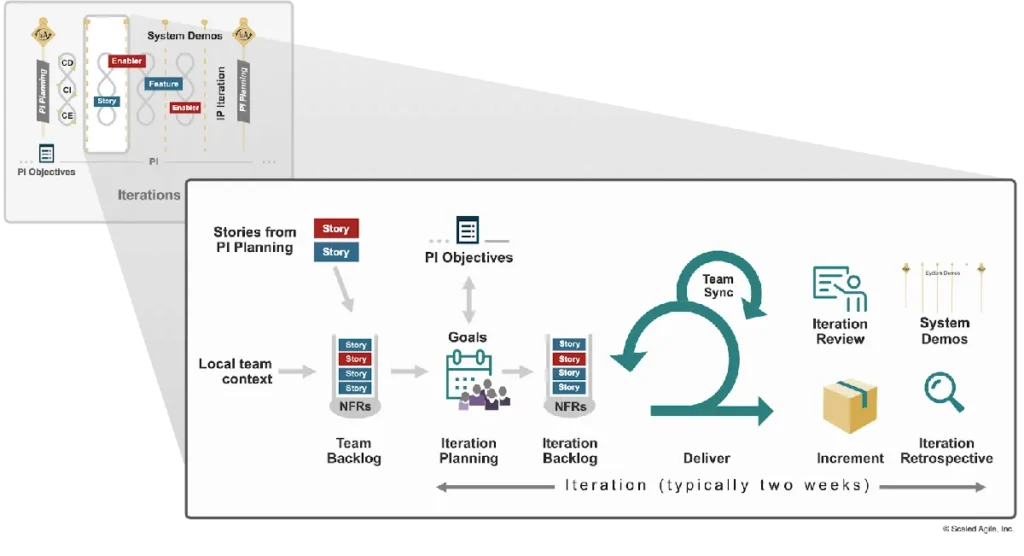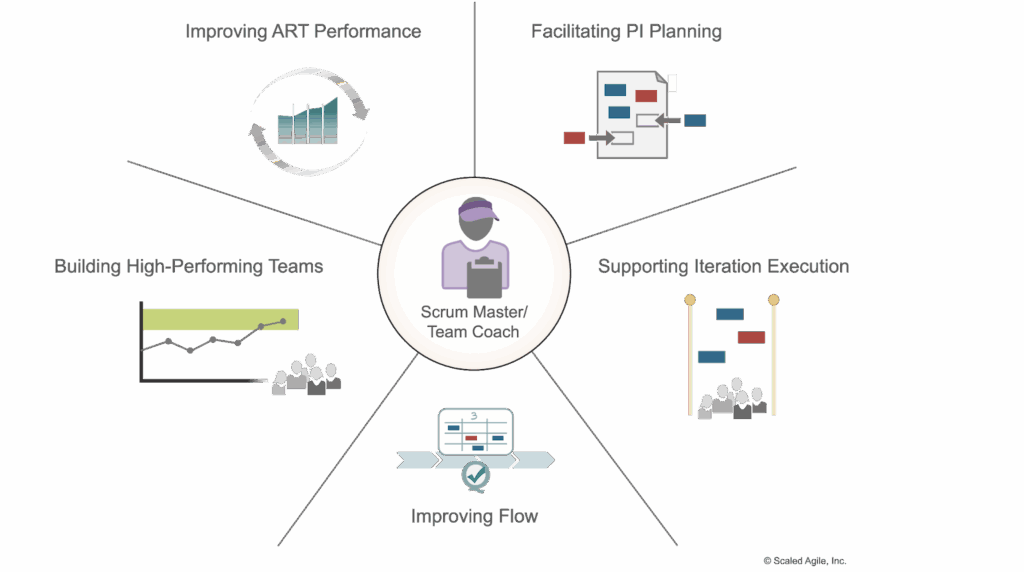When you first hear the job title, you may wonder: what is a scrum master? Let’s start there – a scrum master helps facilitate the work of a team using scrum. Most often, their job is to enable, coach, and support software development teams to build and deliver products through scrum methods.
Your next question is likely – what is scrum? Or, this sounds like a project manager – how is a project manager different from a scrum master? Why should I even consider becoming a scrum master?
To start, as traditional career paths are disrupted, we know that many professionals are seeking ways to advance their careers and learn skills that can flex and adapt across industries. The SAFe Careers Snapshot shows that a majority of open scrum master positions in 2024 required or strongly preferred a certification to show competency, especially if job candidates had less hands-on experience in a prior role. With scrum master training and experience, you can start to pioneer a new career path that’s flexible, fulfilling and financially rewarding.
The Definition of Scrum
Scrum describes a set of practices that emphasize transparency, iterative development, built-in quality, and incremental value delivery within time-bound periods. These practices combine to create a simple and effective agile development approach that keeps cross-functional teams focused on the continuous release of customer value.
In SAFe, teams use scrum principles to execute in alignment with the broader agile framework used across other teams and departments.

Scrum Master Responsibilities Explained
A Scrum Master’s main job is to help teams work efficiently using Scrum. At a high level, they:
- Facilitate key events like stand-ups, sprint planning, and retrospectives. Their role is to keep these points of synchronization focused and productive.
- Clear roadblocks that could be slowing the team down. This might include lack of alignment, external pressure, dependencies, and more.
- Coach the team to help improve value delivery. Scrum masters help team members understand and apply Scrum principles that drive quality and speed without sacrificing predictability.
- Protect focus by shielding the team from distractions so they can deliver work without unnecessary interruptions.
- Foster a culture of learning, iteration and adaptability through team demos, retrospectives, and inspect and adapt sessions
- Work cross-functionally to ensure smooth collaboration across departments and alignment with company goals. This includes planning, execution, delivery, and measurement of results.
The application of scrum within an organization can vary widely, which will ultimately determine day-to-day responsibilities. As an example, the following image shows how a scrum master works within the context of an organization using the Scaled Agile Framework (SAFe):

What Are the Required Skills for a Successful Scrum Master?
Now that we understand the responsibilities of a Scrum Master, let’s talk about what a good scrum master looks like. Scrum Masters come from various backgrounds, and they typically excel at coaching, teaching, and attention to detail. Additionally, they likely bring a strong mix of empathy and high emotional intelligence to help encourage a collaborative environment. The most common skills for scrum masters typically include:
- Strong facilitation experience
- Problem-solving and conflict resolution
- Clear Communication and ability to provide clarity
- Proficiency with ALM and/or project management tools
- Understanding of key metrics like burndown, velocity, and flow
Employers may also seek varying depths of technical capabilities or background in conjunction with these “soft” skills.
What are Similar Roles to a Scrum Master
When researching what a scrum master is, you’ll likely see lots of different job titles. Though some are simply called “scrum master,” here are other common job titles:
- Scrum lead
- Technical project manager
- Agile Coach
- Agile Facilitator
- Iteration Manager
- Agile Delivery Lead
- Agile Project Manager
- Flow Manager
- Agile Team Coach
- Development Process Manager
- Lean-Agile Coach
While this is a long list, one of the most common comparisons is a scrum master vs a project manager. What are the biggest differences?
Scrum Master vs. Project Manager
Focus
A scrum master focuses mainly on the team and the process, removing impediments and coaching the team to improve their efficiency and collaboration.
A project manager focuses on delivering the project on time and within budget by managing all logistics, resources, and risks.
Methodology
A scrum master operates within the Agile framework, as an example, SAFe. They are responsible for ensuring that the team follows SAFe, events (like daily stand-ups and sprint reviews), and artifacts (like the product backlog).
A project manager can work with a variety of methodologies, including traditional “waterfall” project management, Agile, or a hybrid of both. The methodology used depends on the project’s nature and the organization’s structure.
Leadership Style
A scrum master acts as a servant leader. They empower the team to self-organize and make their own decisions. The scrum master’s job is to support the team by removing obstacles and fostering an environment where they can be as productive as possible.
A project manager typically uses a more directive style of leadership, through assigning tasks, making critical decisions, and holding the ultimate accountability for the project’s outcomes.
Scrum Master Certifications & How to Choose One
A Scrum Master certification is a professional designation that establishes your credibility and is a recognizable standard of baseline knowledge. The amount of time and financial investment required will vary across different types of certifications, and it’s wise to research the marketability of the certification and the reputation of the training provider before making your final decision.
Multiple organizations offer scrum master training and certifications, including Scrum.org, Scrum Alliance, and Scaled Agile Inc. These certifications span a range of difficulty, experience levels, and areas of specific Scrum methods. Some of the most popular, rigorous, and well-recognized scrum master certifications for professional development and advancement include:
- Certified Scrum Master (CSM) – This entry-level certification from Scrum Alliance focuses on foundational Scrum knowledge, demonstrated through a required exam.
- Professional Scrum Master (PSM) – Scrum.org breaks this certification into three levels (PSM I, II, & III) to verify increasing levels of experience and competency, though courses don’t need to be taken sequentially.
- Certified Scrum Professional CSP-SM – A more advanced offering, this certification from Scrum Alliance is intended to develop coaching, facilitation, and leadership skills for scrum masters.
- SAFe Scrum Master (SSM) – This certification covers a scrum master’s role and responsibilities within SAFe, with a particular focus on coordinating teams within an enterprise environment.
- SAFe Advanced Scrum Master Certification Path – This certification path was built for experienced Scrum Masters who want to deepen their knowledge in SAFe and improve advanced facilitation, develop coaching techniques, and optimize team performance.
Choosing the right certification depends on your goals. For example, a Scaled Agile scrum master certification will help you learn foundational aspects of the role and demonstrate your understanding of SAFe. Since SAFe is the most widely used agile framework by enterprises globally, a SAFe Scrum Master certification can better position you for a role within a larger, global organization.
When Do Organizations Need a Scrum Master?
The scrum master serves an important role, even in small organizations. While some companies – especially software development firms – are founded with agile practices at their core, others undergo agile transformations over time. Scrum masters become especially important, though, as organizational leadership seeks to help teams adopt agile practices more effectively and consistently across departments and business units.
Scrum masters can help organizations yield agile benefits at the team level consistently and sustainably with an emphasis on continuous improvement and a clear focus on measuring value.
Scrum Master Salary and Career Outlook
Scaled Agile Inc publishes an annual SAFe Careers Snapshot that summarizes trends for different kinds of agile roles, including the required skills, desired certifications, and salaries. Our 2025 careers snapshot found that, the average salary of a scrum master breaks down as follows:
- Scrum Masters: $105,972
- SAFe Certified SAFe Scrum Masters: $119,500
The Scrum Master serves an important role in both large and small organizations. While some companies – especially software development firms – are founded with agile practices at their core, others undergo agile transformations over time. Scrum masters become especially important as executive leadership seeks to help teams adopt agile practices to drive business outcomes more effectively and consistently across teams, departments, and business units.
How to become a Certified Scrum Master
Earning your scrum master certification starts with finding a training provider. Most organizations that create and maintain certification materials, including Scaled Agile, will provide a certification class finder of approved providers. Training providers may offer in-person options, virtual sessions, or both. If you’re interested in earning a SAFe Scrum Master certification, you will receive:
- Attendance at a multi-day training course (typically instructor-led)
- A corresponding course exam
- A shareable certificate of completion and/or digital badge
- Professional membership in a community of practitioners
Plus, you can review the complete guide to Scaled Agile certifications for more detailed information on training, the certification process, pricing, and a lot more!